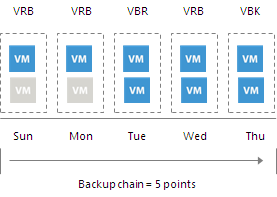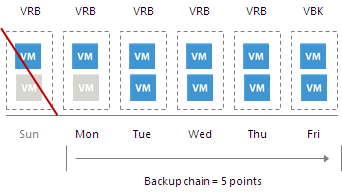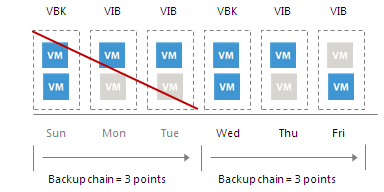 This is an archive version of the document. To get the most up-to-date information, see the current version.
This is an archive version of the document. To get the most up-to-date information, see the current version.Removing Restore Points from the Backup Chain
To keep up with the retention policy, Veeam Backup & Replication deletes the whole backup file from the backup chain, not data for separate VMs from the backup file. For this reason, in some situations a certain VM may have fewer restore points in the backup chain than it is specified in the retention policy settings. This can happen if a backup job processes a number of VMs or VM containers and some VMs or VM containers fail to be processed in some job sessions.
Removing Restore Points from Reverse Incremental Chains
In case of a reverse incremental backup chain, Veeam Backup & Replication immediately deletes a redundant restore point when the allowed number of restore points is exceeded. For more information, see Retention for Reverse Incremental Backup.
For example, a backup job processes two VMs: VM1 and VM2. According to the retention policy settings, the backup chain must contain 5 restore points. The backup job has already had 5 job sessions and VMs have been processed in the following way:
VM1 has been successfully backed up 5 times and has 5 restore points
- VM2 has failed to be processed in two job sessions and therefore has 3 restore points

After that, Veeam Backup & Replication runs a new backup job session in which VM1 and VM2 are successfully processed. When a new restore point is added to the chain, Veeam Backup & Replication removes the earliest restore point because the number of restore points in the backup chain has exceeded 5. As a result, you will have 5 restore points for VM1 and 4 restore points for VM2.

Removing Restore Points from Forward Incremental Chains
In case of a forward incremental backup chain, Veeam Backup & Replication does not remove a restore point immediately. Instead, Veeam Backup & Replication waits for a new full backup (synthetic or active) to be created and a new backup chain to be started. As soon as the last incremental restore point in the "old" backup chain is marked as redundant, Veeam Backup & Replication removes the whole "old" backup chain from the backup repository. For more information, see Retention for Incremental Backup.
For example, a backup job processes two VMs: VM1 and VM2. According to the retention policy settings, the backup chain must contain 3 restore points. The backup job has already had 5 job sessions and VMs have been processed in the following way:
- VM1 has been successfully backed up 3 times and has 3 restore points
- VM2 has failed to be processed in 2 job sessions and has 1 valid restore point
When a new restore point is added to the backup chain, Veeam Backup & Replication will not remove the earliest restore point from the backup chain. Veeam Backup & Replication will wait until a new full backup and 2 incremental backups are added to the backup chain. After that, the whole outdated backup chain will be removed from the backup repository. Restore points in the "new" backup chain, at the same time, may contain data for both VMs or for one VM only: Veeam Backup & Replication regards backup files as restore points, not separate VMs in these files.

Related Topics